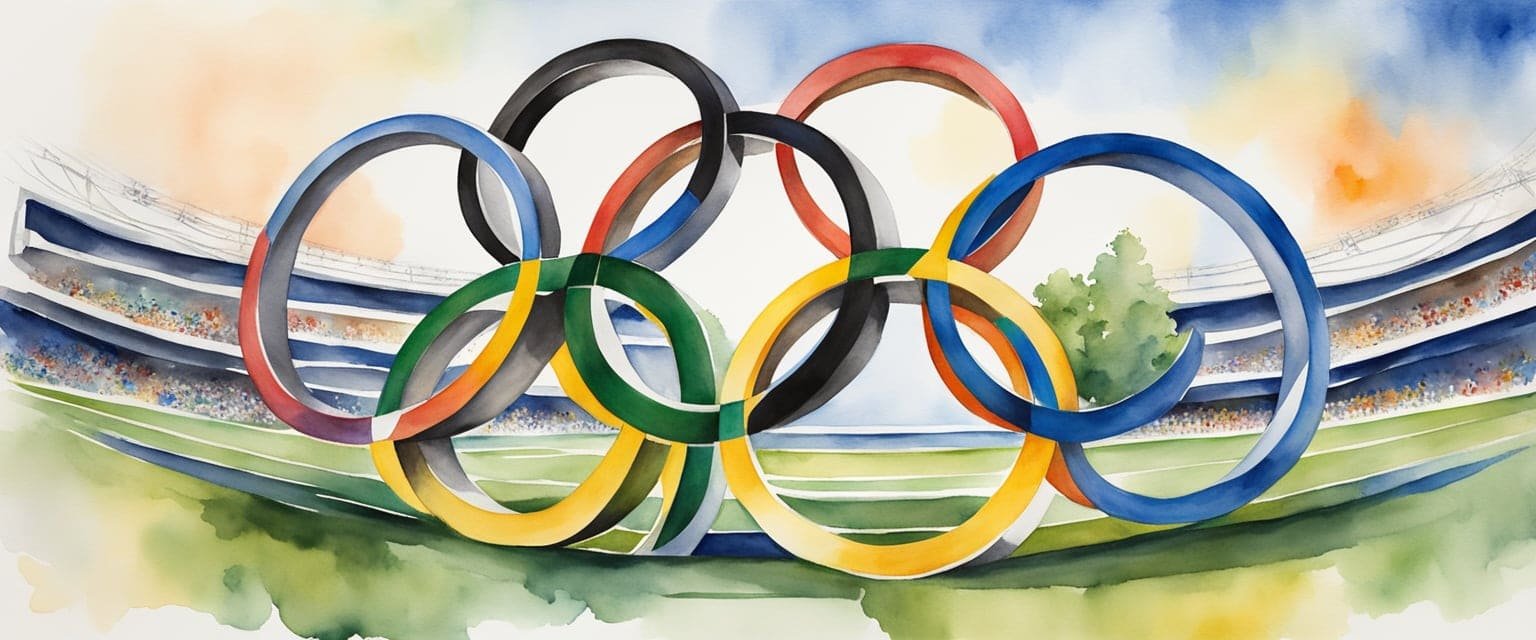Olympic football is more than just a game; it’s a celebration of skill, teamwork, and international spirit. The competition showcases the best young talents from around the world, with national pride on the line and dreams of attaining Olympic glory. From its beginnings over a century ago to the present day, Olympic football has evolved significantly while maintaining its thrilling essence.

I’m excited to explore the rich history of this tournament, highlighting its impact on both players and fans. I’ll dive into the exciting rules, the structure of the events, and the inspiring stories behind the teams and athletes competing for gold. Whether you are a seasoned fan or new to the sport, there’s something here for everyone to enjoy.
Key Takeaways
- Olympic football has a rich history that has shaped its current format.
- The tournament features both men’s and women’s competitions, showcasing global talent.
- Understanding its rules and structure enhances the viewing experience for fans.
History of Olympic Football
Olympic football has a rich history that dates back to the very first Games. Over the years, the sport has evolved significantly, showcasing memorable tournaments and iconic matches.
Early Beginnings and Evolution
Football made its debut at the Olympics in 1900, just four years after the first modern Games. At that time, it was a men’s event only. Two years later, the Olympic football tournament was officially recognized by FIFA.
The early tournaments faced challenges, especially regarding the rules of amateurism. In 1928, football was temporarily removed due to disputes between the International Olympic Committee (IOC) and FIFA over these rules. It returned for the 1936 Berlin Games, and from then on, football has been a staple of the Summer Olympics.
Women’s football was added in 1996, marking a significant step toward inclusivity. Today, both men’s and women’s competitions draw large audiences and showcase top talent from around the world.
Memorable Olympic Football Tournaments
One of the most unforgettable moments happened during the 1984 Olympics when FIFA allowed professional players to participate. This led to a new standard of play and excitement.
Spain secured the gold medal in 1992, hosting the Games, and Argentina took home the title in 2004, reflecting the sport’s popularity in those countries. Germany has also been a strong contender, winning medals in several tournaments.
The competition structure includes a gold medal match and a bronze medal match, intensifying the rivalry among teams. Each tournament offers thrilling moments, making Olympic football an essential part of the Games’ history.
Olympic Football Structure
Understanding how Olympic football operates is key to enjoying the tournament. The structure includes a detailed qualification process and a tournament format that shapes how teams compete.
Qualification Process
The journey to the Olympics starts with the qualification process. For men’s football, teams compete in continental tournaments. These include the UEFA European Championship, the CONCACAF Gold Cup, and others.
Each confederation has its own number of slots, leading to a competitive atmosphere. For example, the top teams from the UEFA Under-21 Championship often qualify.
On the women’s side, the qualification process also takes place through continental championships. A mix of playoff matches and automatic qualifiers makes the path exciting yet challenging.
Tournament Format
The tournament format is crucial for how matches unfold. Men’s and women’s competitions usually start with a Group Stage, where teams are divided into groups of four. Each team plays the others in their group once.
The top two teams from each group advance, leading to the Knockout Rounds. In this stage, it’s all about elimination, starting with the Quarter-Finals. Each match in these rounds is a must-win, adding excitement.
« Ultimate Guide to Olympic Flag Football: Everything You Need to Know to Play and Enjoy
Ultimate Guide to Olympic Handball: Rules, Tips, and Strategies for Success »
Teams face do-or-die scenarios as they compete for medals. The structure ensures a thrilling experience for fans and players alike.
Rules and Regulations
In Olympic football, there are specific rules that guide the competition. These rules ensure fair play and a level playing field for all teams. I’ll cover important aspects like age restrictions, squad composition, and match regulations.
Age Restrictions and Overage Players
In Olympic football, players are generally limited to an Under-23 (U-23) age eligibility. This means that players must be 23 or younger at the start of the competition. I find it interesting that national teams can include up to three players who exceed this age limit. This allows teams to add some experience to their rosters without breaking the age rule. This mix of youth and experience can be a strategic advantage in tight matches.
Squad Composition
Each Olympic football team can have a squad of 18 players. This rule applies to both men’s and women’s teams. Within the squad, only 11 players can be on the field at any given time. I think it’s important to note that teams must choose their players wisely. Coaches have to balance skill, physicality, and team chemistry. The selection of U-23 players also requires careful consideration, as their performance can define the team’s success in the tournament.
Match Regulations
In the matches, teams earn three points for a win, one point for a draw, and no points for a loss. This scoring system encourages competitive play, as teams aim for victories. Each game typically lasts for 90 minutes, split into two 45-minute halves. If the match ends in a draw during knockout stages, extra time and potentially a penalty shootout are used to determine the winner. Following these regulations helps maintain the excitement and integrity of the tournament.
With these rules and regulations, Olympic football maintains a balance of fairness and competitive spirit.
Participating Teams and Players

In Olympic football, various national teams come together, showcasing their talents on an international stage. Football has a rich history in the Olympics, with several countries standing out as historically successful. In addition, many footballers have made a name for themselves through their Olympic performances.
Historically Successful Countries
Some countries have proven to be strong contenders in Olympic football. Brazil is particularly known for its success, having won multiple gold medals. Their unique playing style has captivated fans worldwide.
Australia has also made significant strides in Olympic football, especially among women’s teams. The USA is another powerhouse, consistently showing strength in both men’s and women’s competitions. Egypt has left its mark as well, showcasing great talent over the years.
Countries like England and France have also competed fiercely, striving for medals. New Zealand, while less dominant, has shown spirit and talent, especially in the women’s game.
Notable Footballers in Olympics
Several footballers have made a lasting impact on the Olympic stage. Sam Kerr from Australia is a standout player, known for her goal-scoring ability and leadership on the field. Her performances have drawn attention and admiration globally.
Another notable player is Brazil’s Neymar, who shone during the 2016 Games, helping his country secure a gold medal. The USA’s Megan Rapinoe is also worth mentioning; she has been instrumental in raising awareness for women’s football.
These athletes, among others, represent the competitive spirit and passion found in Olympic football, inspiring future generations to pursue the game.
Women’s Olympic Football

Women’s Olympic Football has seen impressive growth and interest over the years. As nations showcase their talent, the tournament becomes a stage for powerful performances and stories. I’m excited to share the key aspects that highlight its rise and the main teams that have shaped its history.
Rise and Growth
In recent years, Women’s Football has gained significant momentum. The tournaments, including the Women’s World Cup, have helped raise the profile of female athletes and the sport itself.
Participation has surged in countries like the USA, Canada, and Great Britain, making it a global affair. The 1996 Atlanta Olympics was the first to include women’s football, paving the way for greater recognition.
More nations, including Wales, have started to invest in women’s leagues and youth programs, emphasizing development at grassroots levels. As a result, the Olympic platform has driven competitiveness, showcasing emerging talents and established stars alike.
Major Contenders and Achievements
In the realm of Women’s Olympic Football, a few countries stand out as major contenders. The USA has been a dominant force, winning gold medals in 1996, 2004, and 2008. Their team has produced many famous players, including Abby Wambach and Megan Rapinoe.
Canada has also claimed success, bringing home a bronze medal in 2012 and a gold in 2020. Their steady rise in the sport has made them one to watch. Great Britain, while not always consistent in the Olympic arena, has developed a solid team that garners attention during tournaments.
The competition is fierce, with nations continuously raising their game. With the upcoming Paris 2024 Olympics, I’m eager to see how these talented teams perform on the global stage.
Olympic Football Venues

When it comes to Olympic football, the venues play a crucial role in shaping the experience. The stadiums are not just places to watch games; they reflect the culture and spirit of the host cities. In this section, I’ll cover the key stadiums and facilities used for the Olympics and how hosting impacts the surrounding cities.
Stadiums and Facilities
For the Paris 2024 Olympics, several iconic stadiums will serve as venues for football matches. Notable stadiums include:
- Parc des Princes: This well-known stadium will host matches and is famous for its vibrant atmosphere.
- Stade de Bordeaux: A modern facility that was built for Euro 2016 and will contribute to the excitement during the Olympics.
Each venue will be equipped with state-of-the-art facilities to ensure a great experience for fans and players alike. The International Olympic Committee (IOC) places great importance on the quality of these venues to meet international standards. Lessons from the Tokyo 2020 Olympics help enhance these facilities for the upcoming events in Paris.
Hosting Cities and Their Cultural Impact
The cities hosting the Olympic football matches bring their unique culture to the events. For instance, Paris is known for its rich history, food, and art. This cultural backdrop adds a special element for visitors and athletes alike.
These cities make football more than just a game; it becomes a shared experience. Street festivals, local cuisine, and the vibrant local community around stadiums enrich the overall atmosphere. Events like these help to promote tourism and showcase the best of what the host city has to offer.
In summary, the venues and their locations are central to the Olympic football experience, influencing both the games and the cultural interactions around them.
Preparing for Olympic Football
Getting ready for the Olympic Football tournaments involves a lot of planning and training. It’s crucial for teams to be in top shape before matches. I’ll cover the importance of pre-tournament training and how teams handle injuries and replacements.
Teams’ Pre-Tournament Training
Before the tournament kicks off, teams engage in focused training sessions. This helps build teamwork and sharpens their skills. Coaches create specific schedules to balance practice with recovery.
I’ve seen that teams often hold boot camps or training camps. These can last several weeks. Players work on tactics, set pieces, and fitness drills.
Nutrition plays a key role too. Players need to eat right and stay hydrated. Many teams consult dietitians to optimize their meal plans. Staying fit helps players perform well in crucial matches.
Dealing with Injuries and Replacements
Injuries are a part of sports, and preparing for them is essential. Teams must have a plan for handling injuries if they occur during the tournament.
When a player gets injured, they often need to be evaluated quickly. Medical teams assess how severe the injury is. If a player can’t continue, the coach selects a replacement from the squad.
This is why depth in the squad is important. Coaches look for players who can step in without losing quality. Keeping an eye on player health through regular check-ups can also help reduce injury risks.
Cultural Impact and Legacy

Olympic Football has shaped cultures and nations in unique ways. It has created a platform for showcasing talent and has driven national pride among participating countries. The games bring people together, celebrating both athletic skill and cultural identity.
Olympic Football’s Influence on Global Football
I see Olympic Football as a significant stepping stone for many players. Countries like Brazil and Germany have often used this stage to spotlight emerging talents. Players like Neymar showcased their skills on this big platform, influencing fans and future stars.
In France, success in Olympic Football has fueled dreams of international glory. The performance of the French team often encourages youth participation in the sport. Japan also utilizes the games to promote football, inspiring young athletes to pursue their dreams on a global level.
Stories of National Pride and Spirit
Every Olympic event, especially football, stirs deep feelings of national pride. I find it fascinating to observe how countries rally behind their teams. For many fans in Brazil, the tournament is a chance to celebrate their rich football culture.
In Germany, the tradition of football runs deep, and success at the Olympics brings a wave of excitement and inspiration. Each victory ignites a passion that resonates through local communities. These stories of perseverance and triumph highlight the spirit that football instills in people’s lives.
Ultimately, these moments create connections that go beyond the sport itself, uniting nations in celebration and effort.
Future of Olympic Football
The future of Olympic football looks promising with the rise of new teams and potential changes in the rules. I’m excited to see how these elements will shape the tournament in the coming years.
Emerging Nations and Teams
The landscape of Olympic football is rapidly evolving. Traditionally strong teams like Brazil and Argentina are now facing competition from emerging nations. Countries like Uzbekistan, Iraq, and Zambia have shown impressive growth in their football programs.
I believe we can expect to see teams like Morocco and Colombia making strides on the international stage. The involvement of nations such as Dominican Republic and Guinea in youth tournaments is encouraging. These teams have the potential to surprise established powers as their players gain experience on bigger platforms. As these nations develop, they will bring fresh talent and excitement to the Olympics.
Innovations and Changes in Rules
Innovations in football often lead to thrilling gameplay. During the next Olympic cycle, we may see new rules aimed at increasing scoring opportunities and enhancing viewer engagement. The inclusion of Futsal could also play a role, providing a different style of play that emphasizes skill and creativity.
Age restrictions may be revisited to encourage younger talent while maintaining a competitive edge. I think these adjustments could make future tournaments more dynamic and appealing. Keeping an eye on these potential changes will be essential for fans and teams alike. With each competition, Olympic football has the chance to grow and adapt, ensuring a vibrant future for the sport.
Frequently Asked Questions

I often get questions about Olympic football, especially with the 2024 Games approaching. Here are some specific details that answer common curiosities about the tournament.
What is the qualification process for Olympic football in 2024?
The qualification process for the 2024 Olympic football tournament involves different pathways for men and women. Each confederation has its own tournaments, with top teams earning their spots for the Olympics.
What teams are competing in the 2024 Olympic football tournament?
In 2024, the men’s tournament will feature 16 teams, while the women’s tournament will include 12 teams. These teams are determined through qualification events held by each football confederation.
When does the football event schedule begin in the 2024 Olympics?
Football events at the 2024 Olympics will start on July 24, 2024. Matches will take place in various venues across Paris and other locations during the Olympic period.
Are professional players eligible to compete in the men’s Olympic football?
Yes, professional players are allowed to compete in the men’s Olympic football tournament. However, there’s typically an age limit, with most teams featuring under-23 players, plus a few overage players.
How can I find the Olympic football 2024 schedule in PDF format?
The official Olympic website will provide a PDF version of the football schedule closer to the event. I recommend checking their site for the most accurate and updated information.
Which channel will broadcast the Olympic football matches in 2024?
In the United States, NBC will be the main broadcaster for the Olympic football matches in 2024. Other countries will have their respective broadcasters, so it’s good to check local listings.

